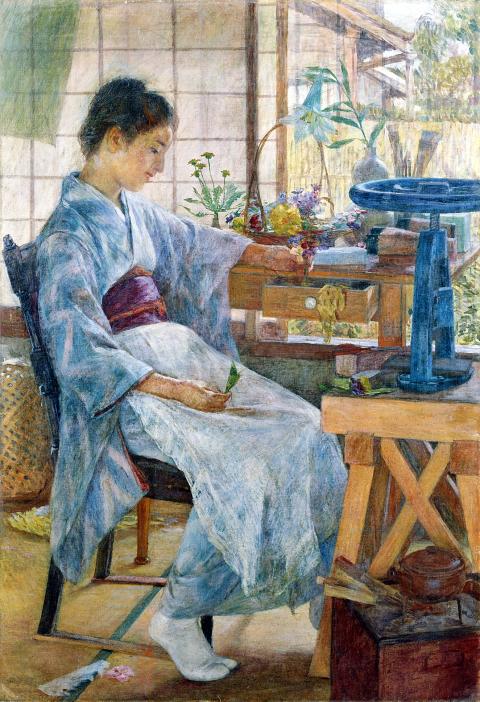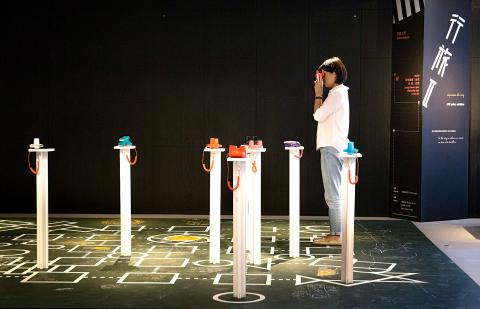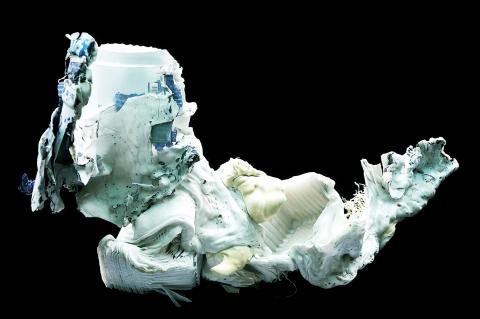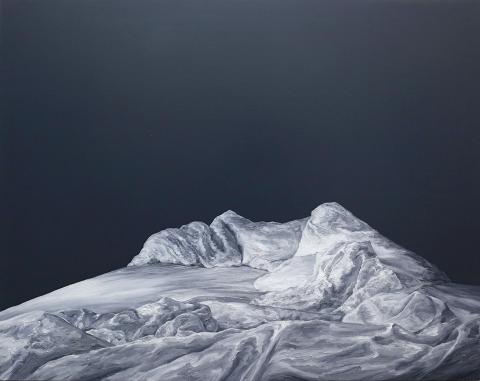Yoga: Modern Western Paintings of Japan (日本近代洋畫大展) is a comprehensive show of Japanese modern paintings that date from the Meiji to Showa period (late 19th century to early 20th century). The show includes over 80 paintings by 31 artists who contributed to the early blossoming of western painting in Japan, including artist and educator Kuroda Seiki, the founding director of the Western Painting Department of Tokyo University of the Arts. Kuroda and his colleague Kume Keiichiro studied in France under French painter Raphael Collin. After returning to Japan, they set up a school to teach western art theories to a wider audience. Kuroda and Kume shared Collin’s interests in developing techniques of illumination. In Kuroda’s Woman (in the kitchen), a modest women in a solemn dress is seated in her kitchen; the scene is depicted with varying white tones to express subtle nuances of light and air. The show features the influences of many European trends, including cubism, fauvism, surrealism, and plein air painting. Also on view are Yorozu Tetsugoro’s ‘Nude’ which renders a female figure with bold strokes and abstracted forms; and the works of Ishikawa Kinichiro, an important figure to the first wave of western painting in Taiwan during the Japanese colonial period.
■ Museum of National Taipei University of Education (北師美術館) 134, Section 2, Heping E Rd, Taipei City (台北市和平東路2段134號) , tel: (02) 6639 6688. Opens Tuesdays to Sundays from 10am to 5pm
■ Through Jan. 7

Photo Courtesy of the Museum of National Taipei University of Education
Chinese artist Zhao Zhao (趙趙) is known for his provocative reflections on contemporary China through a variety of mediums. His current solo exhibition, Self Portrait (自畫像), appears to be relatively subdued; yet underneath its quiet surface, the act of repeatedly painting pictures of himself over an intense period suggests an act of interrogating the idea of ones self image — both in today’s society and in painting history. The show features 36 self-portraits created over the past two years, in which Zhao consistently maintains the same angle and posture with his chin propped up by his left hand and his eyes staring into the distance. Zhao paints with varying treatment of the material surface; a few portraits appear to be quick sketches with bold strokes and big areas of washes; while others are more labored over, decoratively etched out with the brush bristles or colored over with multiple layers. “To Zhao, a self portrait is not a traditional method of capturing the moment… of affirming oneself through expression…,” writes Chinese curator Cui Cancan (崔燦燦). Presented together, each of the 36 portraits struggles to maintain its legitimacy as a defined entity distinct from the other iterations of the self.
■ Lin & Lin Gallery (大未來林舍畫廊) 1F, 16, Dongfeng St, Taipei City (台北市東豐街16號1樓), tel: (02) 2700 6866. Opens Tuesdays to Sundays from 11am to 7pm
■ Through Jan. 14

Photo Courtesy of The Place, Tainan
Experience The City (行旅II) is a group exhibition that features three art projects inspired by the city of Tainan. The exhibition is at The Place, a hotel in Tainan, and occupies an open area on three consecutive residential floors. This refreshing arrangement seems to draw art closer to public life while also highlighting the cultural insights that artists may offer to visitors of the city. The show begins with NDD Design’s (唐草設計) theatrical installation of caricatured street vending trucks that draw from the aesthetic of local street food culture. The vending stations provide special cuisine tips and guides for food walks around town. On the floor above, Chu Yin-hua’s (朱盈樺) Encoding Memories: Tainan shares a collection of stories about Tainan food and local culture. These stories are presented as slides that visitors may flip through with toy slide viewers. Tingshuo’s (聽說) Gentle Steps Listening Walks offers four listening stations of beautifully composed soundscapes recorded from different districts in Tainan. Each station also includes a map of where each soundtrack took place, creating an imaginative guide to people and stories that have occurred around town.
■ Tainan The Place (老爺行旅) 368, Zhonghua E Rd Sec 1, Tainan City (台南市中華東路一段368號), tel: (06) 236 6168. Please contact hotel for gallery opening hours.
■ Through Feb. 28

Photo Courtesy of Lin & Lin Gallery
The Ocean Debris Photography Project by Taiwan-based collective One One & One creates intriguing still life photographs of discarded objects that have been tossed in the ocean and washed back to shore after a period of time. The twisted rubber sole of a shoe, a bent plastic ruler, and a flattened drink bottle are among 111 artifacts that the team collected from Hualian County’s Chihsingtan Beach (七星潭海邊). Chihsingtan Beach offers scenic ocean views, but is also contaminated with garbage, much of which has been eroded by the sea. “The process is almost like we toss something into the ocean, and she gives us back a work of art,” says the team. The photos of these artifacts capture in close detail the washed out colors and distorted shapes of artificial products manipulated by the organic force of the sea. While marveling at the wonders of ocean craft, the team also helps clean up the coast during its documentation process. Hi! We Are Back features the project’s photographs and collected objects.
■ Intzuition (以覺學金工實驗室), 23, Ln 19, Liaoning St, Taipei City (台北市遼寧街19巷23號), tel: 0909 331 521, Opens Wednesdays to Mondays from 11am to 7pm
■ Through Dec. 17

Photo Courtesy of the artist
Since 2015, Chang San-hsueh (張善學) has been creating monochromatic still lifes of blankets, pillows and sheets that he piles on his bed to form mountainous landscape, which he then paints. Chang draws inspiration from his daily surroundings and was first captivated by the sight of his untidy bed as a random composition of ordinary things that seem to have no meaning and yet provide intimate clues of his character. Over the years Chang has continued to make sketches of his bed as a diaristic habit of documenting traces of his everyday life. Wintry Day (冬日油畫個展) shows three paintings from this series that depict his bed-scape in different times of the day. The light falls on the ruffled sheets, creating different shades of gray during the morning, noon and evening. He purposely chooses a colorless palette and plain sheets to create abstract, metaphorical scenes that reflect his daily observations on the natural rhythms of life.
■ A Little Taste (有點品食), 32, Ln 9, Songlong St, Taipei (台北市松隆路9巷32號), tel: (02) 7730-7809. Opens Tuesdays to Sundays from 10:30am to 7pm
■ Through Jan. 28

Photo Courtesy of the artist

In the March 9 edition of the Taipei Times a piece by Ninon Godefroy ran with the headine “The quiet, gentle rhythm of Taiwan.” It started with the line “Taiwan is a small, humble place. There is no Eiffel Tower, no pyramids — no singular attraction that draws the world’s attention.” I laughed out loud at that. This was out of no disrespect for the author or the piece, which made some interesting analogies and good points about how both Din Tai Fung’s and Taiwan Semiconductor Manufacturing Co’s (TSMC, 台積電) meticulous attention to detail and quality are not quite up to

April 21 to April 27 Hsieh Er’s (謝娥) political fortunes were rising fast after she got out of jail and joined the Chinese Nationalist Party (KMT) in December 1945. Not only did she hold key positions in various committees, she was elected the only woman on the Taipei City Council and headed to Nanjing in 1946 as the sole Taiwanese female representative to the National Constituent Assembly. With the support of first lady Soong May-ling (宋美齡), she started the Taipei Women’s Association and Taiwan Provincial Women’s Association, where she

Chinese Nationalist Party (KMT) Chairman Eric Chu (朱立倫) hatched a bold plan to charge forward and seize the initiative when he held a protest in front of the Taipei City Prosecutors’ Office. Though risky, because illegal, its success would help tackle at least six problems facing both himself and the KMT. What he did not see coming was Taipei Mayor Chiang Wan-an (將萬安) tripping him up out of the gate. In spite of Chu being the most consequential and successful KMT chairman since the early 2010s — arguably saving the party from financial ruin and restoring its electoral viability —

It is one of the more remarkable facts of Taiwan history that it was never occupied or claimed by any of the numerous kingdoms of southern China — Han or otherwise — that lay just across the water from it. None of their brilliant ministers ever discovered that Taiwan was a “core interest” of the state whose annexation was “inevitable.” As Paul Kua notes in an excellent monograph laying out how the Portuguese gave Taiwan the name “Formosa,” the first Europeans to express an interest in occupying Taiwan were the Spanish. Tonio Andrade in his seminal work, How Taiwan Became Chinese,